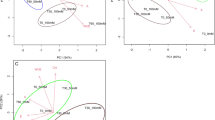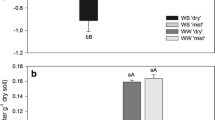Abstract
Two-yr-oldPinus strobus seedling shoots were exposed to pH 5.6, 4.6, 3.6, and 2.6 mists, nightly during a 24-wk period coinciding with the growing season. Throughout the misting period, seedlings were well-fertilized and mist water was excluded from the soil of each seedling in order to render inconsequential the higher nutritional content (NO3 − and SO4 2−) of the more acidified mists. Foliar necrosis appeared in all plants exposed to acidity levels below pH 5.6. Injury magnitude and quantity was pH-dependent, ranging from no injury of the pH 5.6 needles to more than 50% injury of needle tissue from the pH 2.6 group. No significant differences were observed in the macroscopic growth of seedlings between the four different treatment groups. This was determined through measurements of both the seasonal increase in seedling heights and the fascicle lengths at the end of the season. In addition, no statistically significant differences were found at the microscopic level after the measurement of whole-needle transectional areas of healthy-appearing, green needle segments. Areas of component regions in these transections also did not yield statistical differences. These microscopic results combined with the fascicle length measurements lead to the conclusion that needle elongation progressed in a normal, unaffected manner despite needle injury.
Similar content being viewed by others
References
Abrahamsen G (1980) Acid precipitation, plant nutrients and forest growth. In: Drabløs D, Tollan A (eds) Ecological impact of acid precipitation. SNSF Project, Oslo-As, Norway, pp 58–63
Cowling EB, Linthurst RA (1981) The acid precipitation phenomenon and its ecological consequences. BioScience 31:649–654
Crang RE, McQuattie CJ (1986) Qualitative and quantitative effects of acid misting and two air pollutants on foliar structures ofLiriodendron tulipifera. Can J Bot 64:1237–1243
—, — (1987) A quantitative light microscopic technique to assess the impact of air pollutants on foliar structure. Trans Am Microsc Soc 106:164–172
Doak CC (1935) Evolution of foliar types, dwarf shoots, and cone scales ofPinus with remarks concerning similar structures in related forms. Ill Biol Monogr 13:125–230
Evans LS (1984) Acidic precipitation effects on terrestrial vegetation. Ann Rev Phytopathol 22:397–340
—, Miller PR (1975) Histological comparison of single and additive O3 and SO2 injuries to elongating ponderosa pine needles. Am J Bot 62:416–421
Ewers FW, Schmid R (1985) The fate of the dwarf shoot apex in bristlecone pine (Pinus longaeva). Am J Bot 72:509–513
Ferenbaugh RW (1976) Effects of simulated acid rain onPhaseolus vulgaris L. (Fabaceae). Am J Bot 63:283–288
Gordon CC (1972) Mount Storm study. US EPA Contract #68-02-0229, Washington, DC, 31 pp
Hanawa J (1967) Growth and development in the shoot apex ofPinus densiflora, II. Ontogeny of the dwarf shoot and the lateral branch. Bot Mag Tokyo 80:248–256
Hepting GH, Berry CR (1961) Differentiating needle blights of white pine in the interpretation of fume damage. Intl J Air Water Pollut 4:101–105
Hileman B (1983) Acid fog. Environ Sci Technol 17:117A-120A
Hindawi IJ, Ratsch HC (1974) Growth abnormalities of Christmas trees attributed to sulfur dioxide and particulate acid aerosol. Proc Ann Meet Air Pollut Control Assoc #74–252, Denver, 21 pp
Klein RM (1984) Ecosystems approach to the acid rain problem. In: Linthurst RA (ed) Direct and indirect effects of acidic deposition on vegetation. Butterworth Publishers, Stoneham, MA, pp 1–11
Lee JJ, Neeley GE, Perrigan SC, Grothaus LC (1981) Effect of simulated sulfuric acid rain on yield, growth and foliar injury of several crops. Environ Exptl Bot 21:171–185
Levitt J (1980) Responses of plants to environmental stresses, Vol 2: Water, radiation, salt, and other stresses, 2nd edn. Academic Press, New York, 607 pp
Likens GE, Wright RF, Galloway JN, Butler TJ (1979) Acid rain. Sci Am 241:43–51
Linzon SN (1978) Effects of airborne sulfur pollutants in plants. In: Nriagu JO (ed) Sulfur in the environment, Part II: Ecological impacts. John Wiley and Sons, New York, pp 109–162
Luoma JR (1987) Forests are dying but is acid rain really to blame? Audubon 89(2):36–51
Maurice CG, Crang RE (1986) Increase inPinus strobus needle transectional areas in response to acid misting. Arch Environ Contam Toxicol 15:77–82
McColl JG, Johnson R (1983) Effects of simulated acid rain on germination and early growth of Douglas-fir and ponderosa pine. Plant Soil 74:125–129
Miller PR, McBride JR (1975) Effects of air pollutants on forests. In: Mudd JB, Kozlowski TT (eds) Responses of plants to air pollution (Physiological Ecology: A Series of Monographs, Texts, and Treatises). Academic Press, New York, pp 195–235
Ogner G (1980) The effect of growth of Norway spruce on soil acidity by acid irrigation. In: Drabløs D. Tollan A (eds) Ecological impact of acid precipitation. SNSF Project, Oslo-As, Norway, pp 208–209
Paparozzi ET, Tukey Jr. HB (1983) Developmental and anatomical changes in leaves of yellow birch and red kidney bean exposed to simulated acid precipitation. J Am Soc Hort Sci 108:890–898
Pechak DG, Noble RD, Dochinger L (1986) Ozone and sulfur dioxide effects on the ultrastructure of the chloroplasts of hybrid poplar leaves. Bull Environ Contam Toxicol 36:421–428
Reinert RA, Heagle AS, Heck WW (1975) Plant responses to pollutant combinations. In: Mudd JB, Kozlowski TT (eds) Responses of plants to air pollution (Physiological Ecology: A Series of Monographs, Texts, and Treatises). Academic Press, New York, pp 195–235
Rice PM, Carlson CE, Bromenshenk JJ, Gordon CC, Tourangeau PC (1986) Basal injury syndrome ofPinus needles. Can J Bot 64:632–642
Sacher JA (1955) Dwarf shoot ontogeny inPinus lambertiana. Am J Bot 42:784–792
Schefler WC (1979) Statistics for the biological sciences. Addison-Wesley Publishing Company, Reading, MA, 270 pp
Shriner DS (1982) Air pollution impacts on forest trees: Acid deposition. Proc Sov-Am Symp, Tallin, USSR, pp 132–134
Smith WH (1981) Air pollution and forests, interactions between air contaminants and forest ecosystems. Springer-Verlag, New York, 379 pp
Tamm CO, Cowling EB (1977) Acidic precipitation and forest vegetation. Water Air Soil Pollut 7:503–511
Treshow M (1970) Environment and plant response. McGraw-Hill, New York, 422 pp
Vogelmann HW (1982) Catastrophe on Camels Hump. Nat His 91:8–14
Weibel ER (1979) Stereological methods, Vol 1: Practical methods for biological morphometry. Academic Press, Orlando, FL, 404 pp
Wood FA, Pennypacker SP (1976) Etiological study of the short needle disease of pine. In: Proc First Intl Symp Acid Ppt For Ecosys, US For Serv Gen Tech Rep NE-23, Upper Darby, PA pp 977–978
Wood T, Bormann FH (1977) Short-term effects of a simulated acid rain upon the growth and nutrient relations ofPinus strobus, L. Water Air Soil Pollut 7:479–488
Zar JH (1984) Biostatistical analysis, 2nd edn. Prentice-Hall, Englewood Cliffs, NJ, 718 pp
Author information
Authors and Affiliations
Rights and permissions
About this article
Cite this article
Maurice, C.G., Crang, R.E. Foliar injury and shoot growth in response to prolonged acidic misting ofPinus strobus seedlings. Arch. Environ. Contam. Toxicol. 18, 277–284 (1989). https://doi.org/10.1007/BF01056214
Received:
Revised:
Issue Date:
DOI: https://doi.org/10.1007/BF01056214




